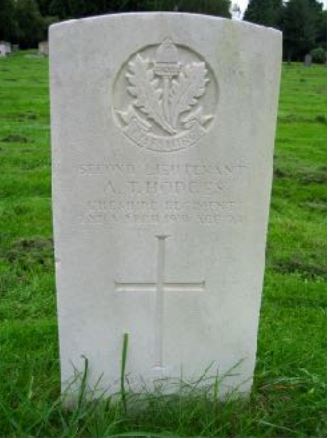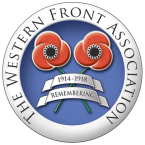15th Battalion, Cheshire Regiment

Arthur Thomas Hodges was born at Ross-on Wye, Herefordshire on 28 September 1890. He was baptised at Tibberton on 7 December of that year. He was the second of eleven children, born between 1889 and 1910 (five boys and six girls) to George James Hodges (a coal merchant: 1860- 1940) and his wife Sarah Louisa (née Teague: 1871-1923). The family home was at 50, Kingsholm Road, Gloucester. At the time of the 1911 Census all eleven children were alive.
The 1911 Census records that Arthur, aged 20, was living in lodgings at King Street, Dawley, near Ross-on-Wye and that he was an Assistant Master at a Church of England School.
Arthur initially joined the Gloucestershire Regiment on 14 September 1914 and was given the number, 13132, indicates that this was probably in September 1914. An obituary published in the Gloucestershire Journal of 8 March 1919 states that Arthur plus two of his brothers volunteered for ‘Lord Kitchener’s Army’, the other two were mobilised as Territorials. Arthur’s service was with the 8th (Service) Battalion of the Glosters. His Medal Index Card (MIC) states that he first went overseas, to France, on 18 July 1915, when the 8th Battalion first deployed.
The above-mentioned obituary states that Arthur saw much action on the Western Front and was twice wounded. The Gloucestershire Journal of 25 August 1917 reported that he had received a commission, from the rank of Acting Serjeant and that he had three brothers serving on the Western Front and one in Palestine. Evidently three had commissions and all appear to have survived the war. According to his MIC Arthur’s commission was effective from 31 July 1917 and he was posted as a Second Lieutenant to the 15th Battalion of the Cheshire Regiment, part of 150 Brigade, 35 Division). It is not known exactly when he joined the Cheshires but there is an entry in the 15th Battalion’s War Diary which states that he was gassed on 20 October 1917. On that day the battalion was employed on working parties conveying duckboards to the front line at Boesinghe in the Ypres Salient.
He was promoted to Corporal on 27 July 1915 and to Acting Serjeant on 3 July 1916. On 18 November of that year he was wounded and treated at 59 Field Ambulance and two days later at 29 Casualty Clearing Station. He rejoined his unit in the field on 18 December 1916. On 14 February 1917 he returned to the UK for officer training, with a view to being awarded a commission. According to his Officer’s File at the National Archives (WO339/102272) he joined the 15th Cheshires, deployed in the Ypres Salient on 25 January 1918. In June 1918 he was diagnosed as suffering from neurasthenia, a nervous condition and after treatment at a Casualty Clearing Station and hospital was struck off the regimental strength and given a fitness category of Bii – which excluded him from front line duty.
According to the obituary, Arthur’s final nine months of Army service were spent acting as Area Commander at ‘Amiens-et-Vaux and Premont’. He was demobilised on 16 February 1919 and returned to the UK, where he planned to resume his teaching position. Unfortunately, he was taken ill upon arriving home and was nursed at home before hospital admission was recommended. He was taken into the Red Cross Hospital, Great Western Road, Gloucester, where he died of double pneumonia, the result of influenza, on 2 March 1919 He was 28 years of age.
His funeral took place on 7 March and he was buried in Gloucester Old Cemetery, where a standard CWGC headstone marks his grave. He is commemorated on the Gloucester War Memorial.
Researched by Graham Adams 20 December 2019
